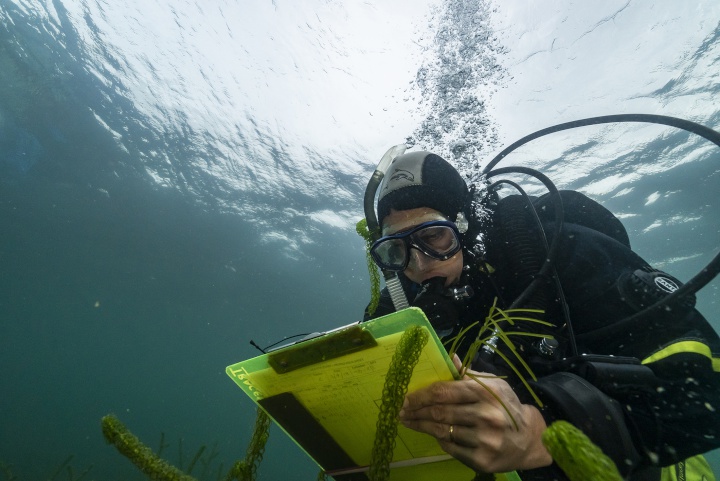Come jump in a lake with NIWA
MEDIA RELEASE
FRIDAY, MAY 31, 2019
Come jump in a lake with NIWA
Visitors to NIWA’s stand at this
year’s Fieldays are invited to go diving with into the
Rotorua lakes -without having to get wet.
NIWA is providing a window beneath the surface of New Zealand’s streams and lakes at Fieldays for people to learn more about our freshwater systems and what keeps them healthy. Through the magic of virtual reality, visitors will take the plunge with NIWA’s specialist divers and swim alongside them as they undertake a survey of underwater plants.

NIWA freshwater ecologist and specialist diver Tracey Burton conducts an underwater survey of plants in Lake Rotomā that gives her an indication of the lake's ecological health. Picture: Rod Budd
The survey is known as LakeSPI (Submerged Plant Indicator) and uses the underwater plants as an indicator of a lake’s ecological health.
LakeSPI surveys have been carried out on 12 Rotorua (Ōkāreka, Ōkaro, Ōkataina, Rerewhakaaitu, Rotoehu, Rotokākahi, Rotomā, Rotomāhana, Rotoiti, Rotorua, Tarawera, and Tikitapu) lakes since 2005 and NIWA freshwater ecologist Tracey Burton says she has seen positive and negative changes.
“Many of the negative changes are attributable to the spread of alien invasive weed species such as hornwort, egeria and lagarosiphon which have had a devastating impact on the some of the lakes. But increased awareness around lake issues and new management initiatives have seen some lakes improve.”
Only two of the 12 Rotorua Te Arawa lakes remain free of major weeds and constant vigilance is needed to prevent the spread of weeds throughout New Zealand’s waterways. This is especially relevant for Lake Rotomā, currently one of the highest ranked lakes in the region.
LakeSPI indicates Rotoma has remained stable with little change for more than 20 years. However just one kilometre to the east is Lake Rotoehu, classified in poor condition, with a heavy infestation of hornwort and water quality issues.
“A piece of weed the size of your thumbnail would be all that it takes for hornwort to be transferred to Rotomā,” Ms Burton says.
“Once in, it would displace the native vegetation in the lake – we’ve already seen this happen in Lake Tarawera and areas of Lake Taupo,” says Burton. “That’s why the ‘check, clean, dry’ message is so important.”
The divers’ observations feed into the national LakeSPI database and build a picture of lake condition and change over the years. The submerged plant indicators help measure two major influences on lake ecology and condition: increased sediments and nutrients and the impact of invasive weeds on native vegetation.
LakeSPI has been used to assess the condition of 305 of New Zealand’s 3,800 lakes, with the data used by the Ministry for the Environment to help describe the state of our freshwater, and it links directly to the Land And Water Aotearoa database (www.lawa.org.nz).
The NIWA Fieldays stand will also house two aquariums – one showing native fish and plants in a good quality environment and the other pest fish and plants in a degraded environment. Scientists will be on hand to discuss to how the health of freshwater environments affects people’s lives.
NIWA ‘s team of weather forecasters will also be at the stand in the main pavilion to answer any questions on the rural climate.


 Engineering New Zealand: NZ Building System Needs Urgent Improvement
Engineering New Zealand: NZ Building System Needs Urgent Improvement GNS Science: Bioshields Could Help Slow Tsunami Flow
GNS Science: Bioshields Could Help Slow Tsunami Flow Transport and Infrastructure Committee: Inquiry Into Ports And The Maritime Sector Opened
Transport and Infrastructure Committee: Inquiry Into Ports And The Maritime Sector Opened Netsafe: Netsafe And Chorus Power Up Online Safety For Older Adults
Netsafe: Netsafe And Chorus Power Up Online Safety For Older Adults RBNZ: 10 Cent Coin With King Charles III Image Now In Production
RBNZ: 10 Cent Coin With King Charles III Image Now In Production NZALPA: Safety Improves From AKL Incident Learnings
NZALPA: Safety Improves From AKL Incident Learnings


